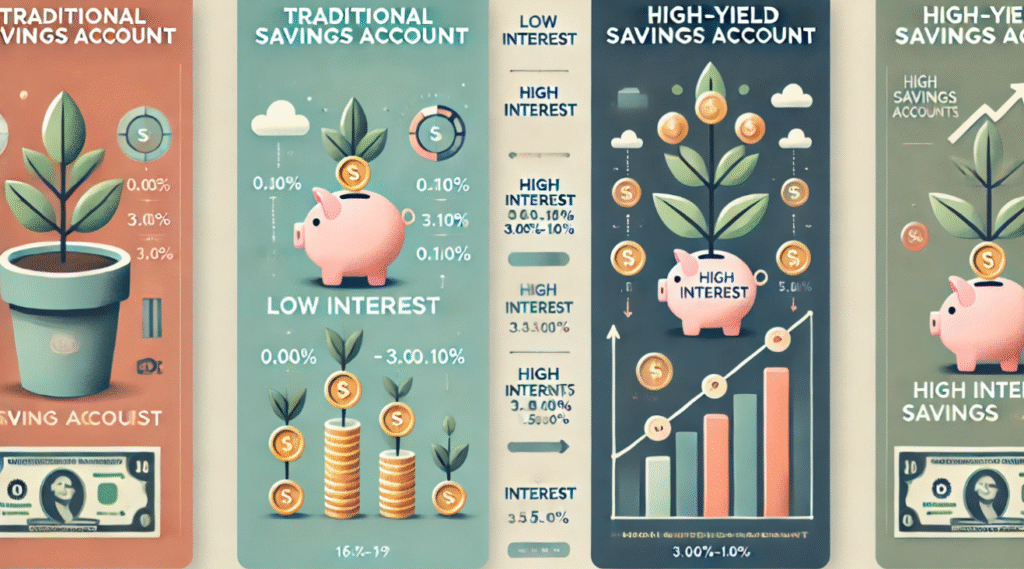
Did you know that nearly 70% of Americans have less than $1,000 in their savings accounts? Saving money and growing wealth is incredibly important for financial stability and security, yet many people struggle to find the right tools to help them achieve their goals. This is where high-yield savings accounts come into play. High-yield savings accounts are a type of savings account that offer a higher interest rate compared to traditional savings accounts. This means that your money can grow at a faster pace, helping you reach your financial goals sooner. The significant advantage of high-yield savings accounts lies in their higher interest rates, accessibility, and long-term growth potential.
What is a High-Yield Savings Account?
A high-yield savings account, or HYSA, is a type of savings account that typically offers a higher interest rate compared to traditional savings accounts. This means that your money can grow at a faster rate over time. The main difference between traditional savings accounts and high-yield savings accounts is the interest rate. Traditional savings accounts tend to offer lower interest rates, while high-yield savings accounts offer higher rates, allowing your money to work harder for you. High-yield savings accounts earn interest at rates typically higher than traditional savings accounts due to several factors such as lower overhead costs for online banks, which allows them to pass on the savings to customers in the form of higher interest rates.
The Key Benefits of High-Yield Savings Accounts
Higher Interest Rates:
APY, or annual percentage yield, is an important factor to consider when looking for a savings account. High-yield savings accounts offer much higher rates compared to regular savings accounts, allowing you to earn more on your money. This is especially important in a high-interest rate environment, as it can make a significant difference in the amount of interest you earn over time. One of the key benefits of high-yield savings accounts is the power of compound interest. With compound interest, you earn interest on both your initial deposit and the interest that has been added to your account. Over time, this can greatly increase the amount of interest you earn, as your savings continue to grow.
Financial Security & Low Risk:
High-yield savings accounts are a great option for those looking for financial security and low risk. These accounts offer competitive interest rates and are often FDIC-insured up to $250,000, providing an extra layer of protection for your funds. In comparison, other investment options such as stocks or bonds carry a higher level of risk and may not guarantee the same level of security. By choosing a high-yield savings account, you can prioritize the safety of your funds while still earning a competitive return.
Liquidity & Accessibility:
Liquidity and accessibility are key features of accounts like high-yield savings accounts or money market accounts. These types of accounts offer easy access to your funds when you need them, making them a great place to store emergency savings or short-term funds without having to worry about market volatility affecting your balance. Additionally, these accounts typically come with minimal fees and require low maintenance. This means that more of your money stays in your account, as you won’t be losing a significant portion of your balance to fees. Overall, these types of accounts offer a convenient and cost-effective way to store and access your funds.

How High-Yield Savings Accounts Help in Specific Financial Goals
Building Emergency Funds:
A high-yield savings account is an ideal choice for building an emergency fund because it offers a combination of high returns and easy accessibility. Unlike traditional savings accounts, high-yield accounts typically offer a higher interest rate, allowing your money to grow more quickly over time. Additionally, these accounts often have no minimum balance requirements and easy online access, making it convenient to deposit and withdraw funds in case of an emergency. This combination of high returns and accessibility makes a high-yield savings account a smart choice for anyone looking to build a financial safety net.
Saving for Large Purchases (Home, Car, Vacation):
High-yield savings accounts can be a great tool for speeding up your savings for large purchases such as a home, car, or vacation. These accounts offer a higher return on your savings compared to traditional savings accounts, allowing your money to grow more quickly. This can help you reach your short- and medium-term savings goals faster and more efficiently. Additionally, high-yield savings accounts can serve as a starting point for long-term wealth building, particularly for retirement or college funds. The higher interest rates offered by these accounts can help your savings grow over time, thanks to the power of compound interest.

How to Choose the Right High-Yield Savings Account for Your Needs
Factors to consider:
When considering a bank account, it’s important to keep several factors in mind. First, be sure to look for the best APY rates that match your financial goals. This will help maximize the interest you earn on your account balance. Additionally, it’s important to choose accounts that have minimal fees and are easy to maintain, so be sure to consider any fees and minimum balance requirements. Accessibility and customer service are also important considerations. Be sure to choose a bank that offers easy access to your funds and has strong customer support in case you have any questions or issues with your account. Finally, consider any special features that may be important to you.
Researching the Best Options:
When researching top high-yield savings accounts, it’s important to compare APY rates, fees, and other features to find the right match for your needs. Start by looking at reputable financial websites and publications that regularly update their rankings of high-yield savings accounts. Pay attention to the APY rates, which represent the annual percentage yield and indicate how much interest you’ll earn on your savings. Also, consider any monthly maintenance fees, minimum balance requirements, and other potential fees that could eat into your earnings. Look for accounts with features that align with your financial goals, such as easy online access, mobile banking options, and FDIC insurance for peace of mind.

The Impact of Compound Interest Over Time
What is compound interest?
Compound interest is the interest calculated on the initial principal, which also includes all of the accumulated interest from previous periods on a deposit or loan. This means that with compound interest, the interest is added to the principal amount, and then the interest is calculated on that new amount. The main difference between compound interest and simple interest is that simple interest is calculated only on the principal amount, while compound interest takes into account the interest that has already been added to the principal. This results in faster growth of the investment or debt. When it comes to high-yield savings accounts, frequent compounding can accelerate your savings growth.

Real-world example:
1.Sure! Let’s say you have $10,000 to deposit into a savings account and you plan to make regular monthly deposits of $
- If you were to choose a high-yield savings account with an interest rate of 3.5%, after 3 years, your total savings would grow to approximately $28,
- Now, if you were to choose a traditional savings account with a much lower interest rate of 5.01%, your total savings after 3 years would only be around $11,
- That’s a significant difference of over $16,000 between the two accounts. This example clearly demonstrates the power of compounding interest and the impact it can have on your savings over time.
Interest Rate Fluctuations:
Interest rates for high-yield savings accounts can fluctuate based on various economic conditions such as inflation, the Federal Reserve’s monetary policy, and overall market conditions. When the economy is strong and inflation is high, interest rates for high-yield savings accounts tend to be higher. Conversely, during times of economic downturn or low inflation, interest rates for these accounts may decrease. As for limitations on withdrawals, high-yield savings accounts may have restrictions on the number of withdrawals you can make per month. This is typically due to federal regulations such as the Federal Reserve’s Regulation D, which limits certain types of withdrawals and transfers from savings accounts to six per month. Exceeding this limit may result in fees or the account being converted to a checking account.
Lower Returns Compared to Investments:
High-yield savings accounts are a great option for those looking for a safe place to park their money. However, it’s important to note that they may offer lower returns compared to investing in stocks or other investment opportunities. While the safety and stability of a high-yield savings account can be appealing, it’s important to weigh the potential for lower returns against the level of risk you’re willing to take on with other investment options.
How High-Yield Savings Accounts Fit into Your Broader Financial Plan
Diversifying Your Savings Strategy:
A high-yield savings account can be a valuable addition to a comprehensive financial plan. While IRAs, 401(k)s, and investment accounts are important for long-term growth, a high-yield savings account can provide a safe and easily accessible option for shorter-term goals. By diversifying your savings strategy, you can balance your risk tolerance with your savings goals, ensuring that you have the right mix of safety and growth in your financial plan. Consider using a high-yield savings account for emergency funds, major purchases, or other short-term goals, while utilizing IRAs, 401(k)s, and investment accounts for long-term growth and retirement planning. By creating a balanced approach, you can maximize the potential of your savings while minimizing risk.

Conclusion
High-yield savings accounts offer several key benefits that make them an attractive option for savers. Firstly, they are a safe and secure way to store your money, as they are typically FDIC-insured up to a certain limit. Additionally, high-yield savings accounts offer higher interest rates compared to traditional savings accounts, allowing your money to grow at a faster pace. They are also very easy to use, often with no minimum balance requirements and convenient online access. I encourage you to explore high-yield savings accounts and consider incorporating them into your financial planning. By focusing on growth and security, you can start building a strong financial future for yourself.













